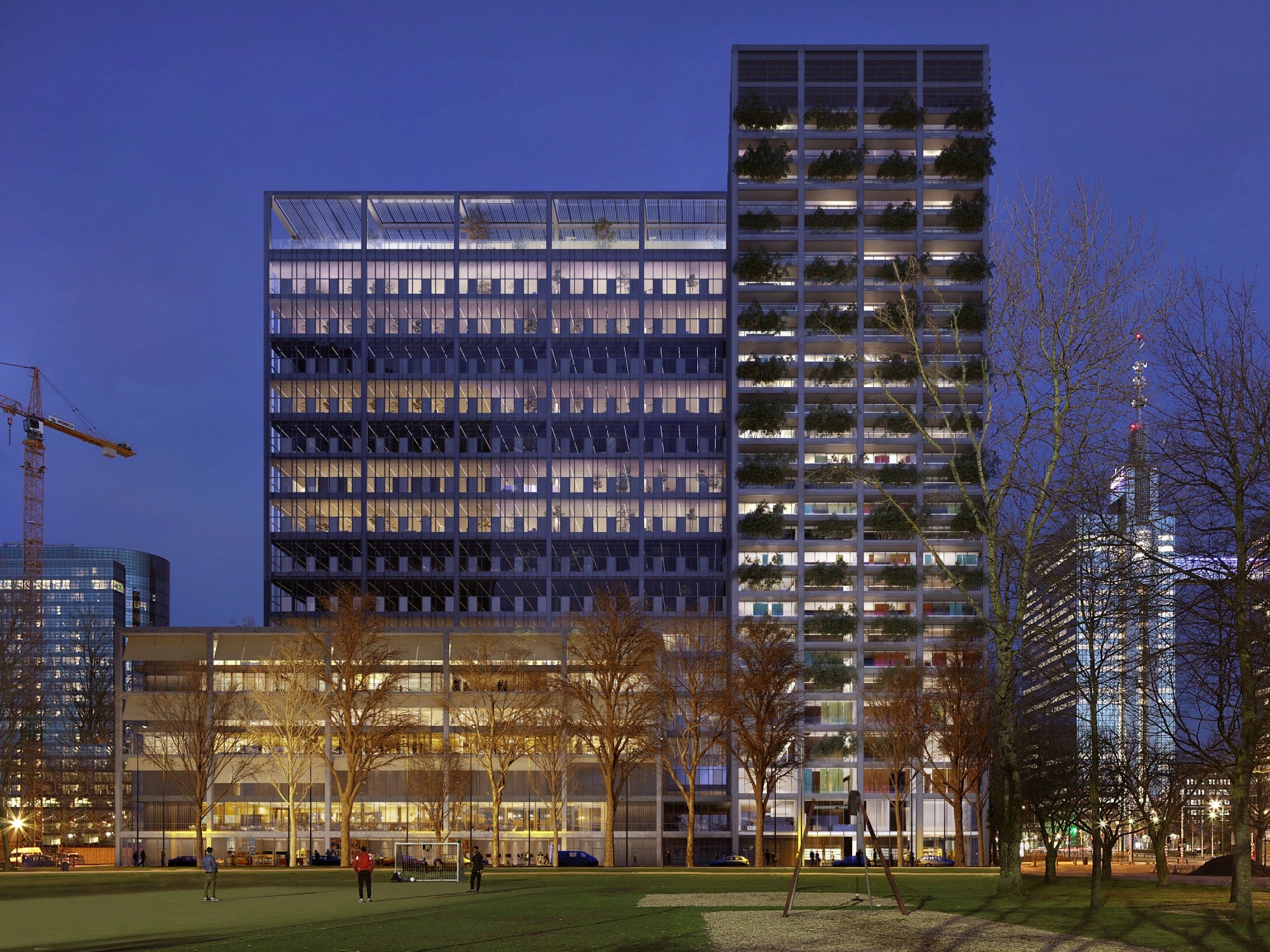Team Building
When it comes to the built environment, we’re all in this together

Hi everyone,
Despite working in adjacent fields, I’ve always kept one eye on new developments in architecture, primarily through the conversations around them. Two recent pieces, both written by younger critics and published in The Nation, converge on an understanding of architecture as both field and practice that I sympathize with and wanted to share.
The first essay, by Kate Wagner, reminds us that because we all live in and move through designed spaces, we are all qualified to have and share opinions about the built environment. Even though we are not architects, those opinions are informed: “I believe very strongly that architecture is for everyone and that most of us are architecture critics in our own right, from the umarells in Italy—old men who stand around and watch construction sites—to my mother watching HGTV and disagreeing with how a particular renovation turned out.”
The second essay, by Marianela d’Aprile, uses a review of architect Reinier de Graaf’s new book Architect, Verb to ask, “What’s the matter with contemporary architecture?” For context, de Graaf is a longtime partner at OMA, the firm cofounded in 1975 by Rem Koolhaas, and the co-founder of AMO, its research arm. In his new book, de Graaf considers ten efforts architecture is “neither able to resist nor capable of fulfilling,” in D’Aprile’s words. Focusing on “the new language of building,” he criticizes the ill-defined use of terms like livability, creatives, and beauty. Perhaps his focus on language, d’Aprile contends, emerges partly from the fact that the challenges facing the profession have “outstripped the architectural tools [de Graaf and others] had to deal with them.” But retreating to complaints about language, she says, is to miss larger, structural problems both within and beyond the profession.
In my reading, both these critics suggest that bettering the built environment requires architects and non-architects to come closer together in their efforts. As d’Aprile suggests, “Instead of indulging in nostalgia, or pretending to have more power than they do, architects should confront the problems already in front of them, of which there are plenty. If the avenues within the profession for addressing those problems are limited, they might find other inroads, not as architects, but simply as people.” From the other direction, Wagner notes, “I don’t like it when people approach me and start their sentences with ‘I didn’t study architecture, but…’ So? Every time you protest rising rents or living conditions, or even just inhabit the commons as a citizen, that’s participating in architecture. Every time you move, rent an apartment, renovate, or decorate, that’s participating in architecture.”
I feel invigorated by this sense of architecture as a common enterprise, of stewarding our built landscape as a shared responsibility (and opportunity). We cannot face our greatest challenges, environmental or social, by remaining passive inhabitants of designed spaces, on the one hand, or by being snobby professionals obsessed only with form-making, on the other.
D’Aprile cites several firms that, “even given the field’s limitations, are attempting to confront some of the problems enumerated by de Graaf”—including Lacaton & Vassal, 2021 Pritzker Prize laureates known for repurposing existing buildings to create affordable social housing. She does not mention one firm I’ve watched with interest in recent years: 51N4E, a “self-steering collective” based in Belgium that “organiz[es] the supportive processes needed for a collaborative design culture.” They have sensitively reoriented a public square in the center of Tirana; created a new masterplan for the renovation of a major hall in the center of Ghent; and created a cotton-candy pink apartment building in Brussels that adroitly negotiates its relationship to a nearby boulevard and park.
But it’s perhaps not a coincidence that the New York Review of Architecture, a vibrant and thoughtful bimonthly print journal and weekly newsletter where d’Aprile is deputy editor, reported on 51N4E’s recent events in New York. These included a lecture at Cooper Union that served as a Stateside launch of its new book How Not to Demolish a Building. That concise volume tells the story of how the firm creatively rethought a 1970s-era Brussels tower block. The conventional approach would be to renovate the existing structures or demolish them and start anew. Instead, the firm obsessively catalogued the existing materials, then designed a new volume that incorporates some of the intact original structure and reuses the raw materials from the rest. According to the NYRA notes, the firm says it conserved “upwards of 62% of the original building’s mass … by turning the site into a ‘marketplace’ of materials.” This is a project worth celebrating and a process worth emulating.

To return to the notion of shared responsibility, one way in which people who are not architects can participate in architecture is by noticing and talking about building and landscape projects that enhance their communities. So let me end with a small story: this weekend, my two young sons got so rambunctious at home that we needed a change of scene. We strapped them into their car seats and ended up at Churchill Meadows Community Center, in a nearby suburb, where I let them loose on a playground we hadn’t visited before.
That playground is part of a fifty-acre landscape characterized by gentle hills made from reclaimed topsoil and features sports fields, a winding trail, and a small wetland. That landscape was created by MJMA, which also designed the community center that anchors it. While my kids played in the unseasonably warm sun, my wife and I sat in the shade offered by laminated-timber columns that angle down from the roof they support and are encased in an aluminum mesh screen. It’s a design touch that gives respite (and a cool snack spot!) to many families and formally echoes the angles of the building’s sawtooth skylights. It also brings a material that dominates the interior onto the outside of the building. In daytime, this screen and some rolling blinds protect the building interior from heat gain. At night, from the pictures I’ve seen, the mesh is transparent enough to reveal the center’s inner structure; the building becomes a glowing beacon of communal activity nestled among these small hills.
Based on my visits to countless other community centers throughout greater Toronto, this building is far better than it had to be—an advertisement, like some recent New York City library branches, that great buildings and landscapes can be made on tight public budgets. I live in an urban neighborhood in the midst of dramatic change. This visit, and the essays above, have strengthened my desire to advocate for this change to be as positive as conditions allow. This kind of advocacy is within reach for all of us.
What are some of the best building projects in your communities? I’d love to hear a story about a place you’ve admired, a landscape you’ve enjoyed traversing, or a rehabilitated building that engages people in new ways.
Love all ways,
Brian
🔗 Good Links
- 📚 An interview with Larry Campbell, who made a living selling used books to The Strand. A vivid, very New York story.
- 📆 “It can feel that every day is just an astronomical calendar invite. It’s so much more.” Jason Farago goes “searching for lost time in the world’s most beautiful calendar.”
- 📐 On the occasion of their first New York gallery show in five years, the NYT profiles the wonderfully inventive artist Tauba Auberbach, with their answers to a questionnaire at the end …
- 🔍 Atlascope “allows for the geographical exploration of Boston through history,” layering old maps onto new in your web browser (via Shannon Mattern)
- ⚜️ The City of Montréal has launched a Design Quality Toolkit that aims to help design professionals enhance “the quality and benefits of urban projects in Montréal.”





